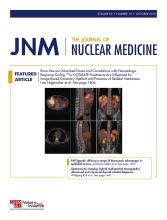TO THE EDITOR: With great interest we read the article “Clinical Outcomes of 177Lu-PSMA Radioligand Therapy in Earlier and Later Phases of Metastatic Castration-Resistant Prostate Cancer Grouped by Previous Taxane Chemotherapy” recently published by Barber et al. (1). We compliment the authors for their work, which has, in part, led to widespread use of this novel class of therapy (2) and inspired prospective trials including the Australian phase II study (3). Nevertheless, we have some concerns about thrusting 177Lu-PSMA as an early line-of-therapy or drawing conclusions from cohorts treated at different disease stages.
The patient cohorts that were compared in the study, as the authors mention themselves, are quite different. The patients pretreated with chemotherapy were significantly sicker than the chemo-naïve patients, for example, concerning Karnofsky Performance Status (P = 0.003), the higher percentage of bone metastases (P = 0.036), and the median initial prostate-specific antigen (PSA) (196.3 vs. 33.6 ng/mL, P < 0.001). Moreover, only 38% of the patients had received either abiraterone or enzalutamide compared with 76% in the taxane-pretreated group, and only 2% had received 223Ra compared with 14%. Thus, the comparison is not really between taxane chemotherapy pretreated and naïve as the manuscript title suggests but between those who had failed multiple lines of therapy and those who had few or none. The longer survival in the latter is subject to lead time bias and completely expected. For this reason, it is uncommon to compare outcome in significantly different patient groups and to draw conclusions based on these findings.
The difference in radiographic progression-free survival (rPFS) for the taxane-naïve and the postchemotherapy patients (8.8 vs. 6.0 mo) and overall survival (OS) (27.1 vs. 10.7 mo) are interesting. rPFS was defined using PSMA PET/CT, which is novel and likely to be more sensitive than conventional imaging. It would be interesting to know the difference in PSA PFS since this is an objective measure that can be compared with other studies; can the authors provide these data? Nevertheless, the difference in rPFS between the 2 cohorts is small whereas the difference in OS is large. This divergence is concerning and might suggest that 177Lu-PSMA radioligand therapy (RLT) responses are not more durable in early stage patients as might be expected. We note that 46% received further 177Lu-PSMA RLT, whereas only 19% received abiraterone or enzalutamide. Could the authors explain why more of these patients did not receive next-generation antihormonal medication, either before 177Lu-PSMA RLT or after progression?
In Germany it is possible to grant access to unapproved therapy such as 177Lu-PSMA RLT by “Compassionate Use” law when there is reasonable doubt to other (approved) options. Chemotherapy eligibility is generally driven by factors including age, performance status, and comorbidities. Fifty-six percent of patients in the chemotherapy-naïve group had Eastern Cooperative Oncology Group (ECOG) 0–1 whereas other factors such as age, baseline renal or liver function did not differ between the 2 arms. Accordingly, it seems likely that a proportion of these were patient-directed rather physician or tumor board–directed decisions. This is increasingly prevalent in the Internet-connected era when news of novel therapies with high promise and low toxicity travels quickly. Although we commend patients for being involved and sharing in decision making, we are concerned that patients` outcomes could be compromised when proven life-prolonging therapies are not used first or even after failure of the novel approach.
Looking at the COU-AA 302 trial in first-line metastatic castration-resistant prostate cancer patients receiving abiraterone, OS was 34.7 mo in the abiraterone group (4). While 38% of the patients in the chemotherapy-naïve group received a novel antiandrogen previously, the other baseline parameters (age, Gleason Score, time from diagnosis, alkaline phosphatase, and PSA) are remarkably similar to the COU-AA 302 cohort. Although it is impossible to compare these cohorts, the longer OS in the COU-AA 302 study is noted. It can be assumed that these patients, at least in part, could have been treated with 177Lu-PSMA RLT. We are hopeful that this may lead to an additional survival benefit, but only prospective studies can prove this. In the meantime, we caution against use of unproven therapies prior to these proven life-prolonging therapies. The results of the ongoing Endocyte VISION (NCT03511664) and ANZUP/PCFA TheraP (NCT03392428) trials are eagerly awaited to provide the first hard evidence on comparative efficacy of 177Lu-PSMA RLT in metastatic castration-resistant prostate cancer patients.
DISCLOSURE
The University of Münster received consulting fees from ABX GmbH, Radeberg, Germany, for Kambiz Rahbar and Martin Bögemann. Additionally, Kambiz Rahbar is scientific advisor of ABX GmbH. Peter MacCallum Cancer Centre has received research funds from Endocyte; Michael S. Hofman is chair of the TheraP study, which is supported by Endocyte. No other potential conflict of interest relevant to this article was reported.
Footnotes
Published online March 29, 2019.
- © 2019 by the Society of Nuclear Medicine and Molecular Imaging.







